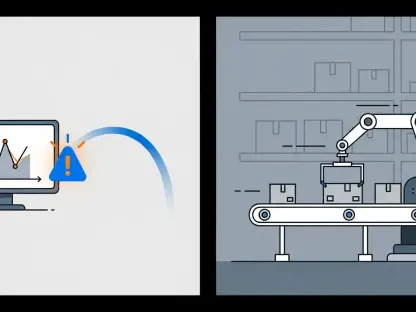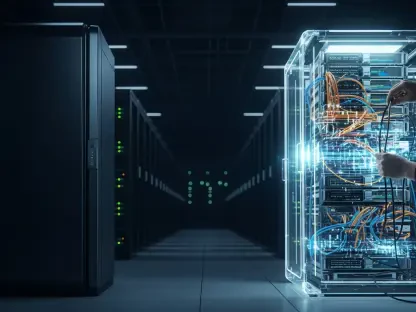In today’s rapidly transforming supply chain environment, predictive procurement empowered by machine learning (ML) has emerged as a vital strategy for businesses seeking to navigate unpredictability. The integration of ML not only enhances procurement processes but also steers them from an era of reaction to one of proactive strategy. By harnessing the power of ML, companies can anticipate market shifts, cost fluctuations, and supply chain disruptions, thus ensuring operational continuity and competitive advantage despite global adversities. This analysis illuminates the transformative potential of ML in predictive procurement, discussing current practices, expert insights, and the future landscape.
Current Landscape and Adoption
Data and Growth Trends
The increasing use of machine learning in procurement is reshaping how companies source products and services. Recent reports illustrate an exponential rise in its adoption, highlighting a leap from basic applications to comprehensive integration. In 2025, the majority of leading companies are actively employing ML to streamline procurement processes, with significant statistics reflecting that nearly 70% of industry leaders have adopted these technologies. Analysts predict that this trend will continue, emphasizing that more enterprises will seek ML solutions to gain a competitive edge in procurement efficiency and decision-making.
Several credible sources highlight how ML is being leveraged to analyze vast volumes of data, identify purchasing patterns, and predict potential supply chain disruptions. As a result, companies are experiencing increasingly efficient procurement cycles, reducing lead times and costs. This surge in ML deployment is propelled by its ability to transform data into actionable insights, which are imperative in today’s complex market conditions.
Real-World Applications
Machine learning applications are diversifying within the procurement sector, providing tangible benefits. Real-world implementations include ML platforms that aid in predicting supplier performance and pricing trends, which help companies make informed strategic decisions. Notable case studies, such as those from leading automotive and consumer goods companies, demonstrate significant cost savings and enhanced supplier relationships through ML-driven insights. Companies like IBM and General Electric serve as pioneers, showcasing the effectiveness of ML in elevating procurement strategies, underscoring its transformational influence.
Procurement teams armed with ML tools can rapidly evaluate alternatives, identify new suppliers, and adjust to evolving market demands. This capability is invaluable amid disruptions like trade tariffs and geopolitical tensions. Through predictive models, businesses can anticipate challenges and adapt their procurement strategies swiftly, thus maintaining resilience against external pressures.
Expert Insights and Perspectives
Industry experts assert that the integration of ML in procurement is not merely an advantage but a requisite for survival in this era. Experts like John Moran, a leading consultant in supply chain technologies, emphasize that predictive procurement offers unprecedented visibility, forecast accuracy, and efficiency. The challenges, however, remain in the adaptation and integration of these technologies within existing systems, as firms must overcome data silos and ensure data integrity for ML models to function effectively.
According to thought leaders, the strategic deployment of ML can dramatically enhance negotiation capabilities by offering data-driven pricing recommendations. As Sarah Masters, a senior procurement strategist, notes, these technologies aid in overcoming typical hurdles such as fluctuating market conditions and unexpected policy changes, fostering better strategic planning and risk management. The potential benefits extend beyond immediate cost savings to improved supplier relations and enhanced supply chain agility.
Future Outlook and Implications
Looking ahead, machine learning in predictive procurement is poised for remarkable advancements, promising a range of benefits and challenges. Future developments are expected to integrate more sophisticated algorithms, enabling richer data analysis and more precise forecasting. The trend extends across industries like technology, retail, and manufacturing, potentially revolutionizing procurement operations with real-time analytics and innovative decision-making tools.
Challenges remain, including data privacy concerns and the requirement for highly skilled professionals to manage these advanced systems. Additionally, businesses face the need for ongoing technological updates and adaptation to ever-evolving market conditions. However, the broader implication is a movement towards procurement processes that are not only efficient but also adaptable to any market circumstance, facilitating a culture of continuous improvement.
The development of predictive procurement suggests a broader industry transformation, with enterprises adopting future-proof procurement strategies that maximize value while minimizing risks. As the trend evolves, companies will likely witness both positive outcomes, such as increased resilience and flexibility, and potential downsides, including increased competition among suppliers adapting to new technological standards.
Conclusion and Call to Action
The integration of machine learning into predictive procurement has undeniably altered procurement dynamics, moving organizations from reactive to proactive strategies effectively. As discussed, the ability of ML to convert extensive data sets into insightful actions empowers procurement teams to navigate market volatility with precision. Businesses that embrace this trend stand to gain significant competitive advantages, achieving resilience and operational excellence amid global uncertainties.
In the coming years, firms that prioritize investment in predictive procurement solutions are likely to sustain operational success and adapt to changing market landscapes efficiently. To remain competitive, companies must focus on advancing their technological capabilities and cultivating a workforce capable of leveraging these tools effectively. The future of procurement lies in strategically combining technology with human expertise, paving the way for sustained growth and innovation.









